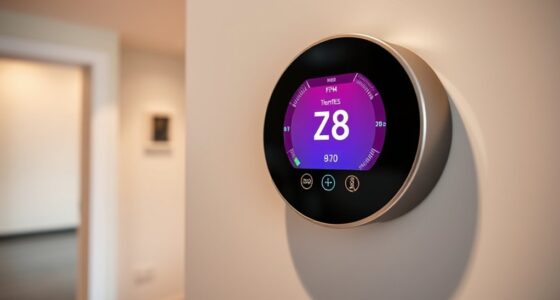If you’re looking for smart thermostats that work seamlessly with Matter for smooth home control, I recommend checking out models like meross, ecobee, and Honeywell, which support popular voice assistants and are compatible with most HVAC systems. These devices often feature easy setup, energy savings, and integration with automation platforms. To find the perfect fit, explore the top options in this list, and you’ll discover more about their features and compatibility options.
Key Takeaways
- Many top smart thermostats now support Matter, enabling seamless integration across multiple smart home ecosystems.
- Ecobee Smart Thermostats Premium and Enhanced are Matter-certified, ensuring compatibility with various platforms.
- Honeywell Home X2S offers Matter support, allowing easy control via popular smart home assistants.
- Compatibility with Matter simplifies setup and enhances interoperability with devices like Alexa, Google, and Apple HomeKit.
- When choosing a smart thermostat, verify its Matter certification for reliable, unified home automation integration.
meross Smart Thermostat with WiFi and Voice Control
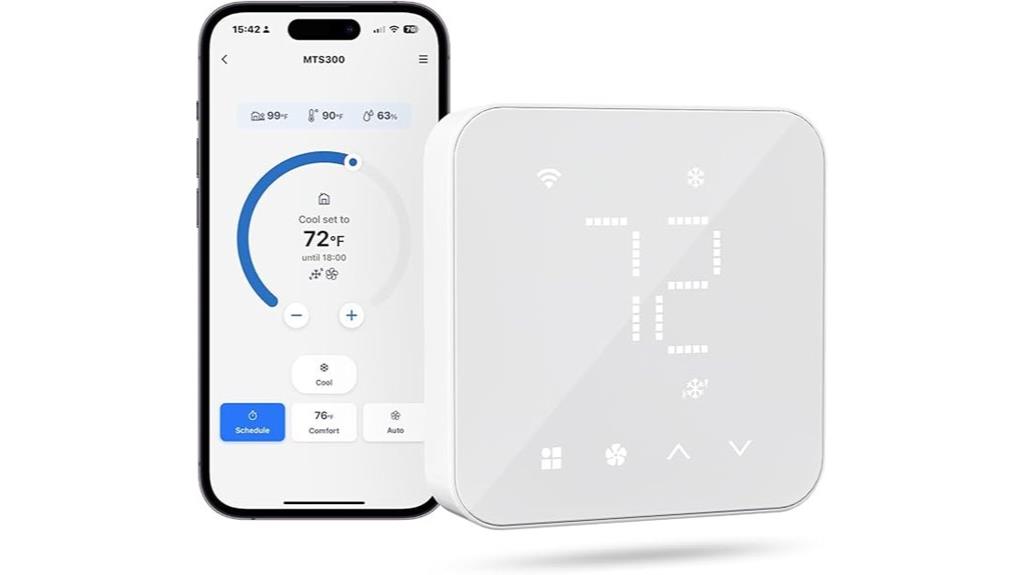
If you’re looking for a budget-friendly smart thermostat that works with most HVAC systems, the meross Smart Thermostat with WiFi and Voice Control is a great choice. It’s compatible with about 95% of HVAC setups, including conventional heating, cooling, and heat pumps—just not electric baseboard heaters. It requires a C-wire for installation, but if you don’t have one, you can buy a Meross C-wire adapter. The thermostat supports 2.4GHz Wi-Fi and offers customizable 7-day schedules, which can run even without Wi-Fi. Plus, it integrates seamlessly with Apple Home, Alexa, Google, and SmartThings via Matter, and you can control it remotely through the app.
Best For: homeowners seeking an affordable, versatile smart thermostat compatible with most HVAC systems and voice platforms.
Pros:
- Compatible with 95% of HVAC systems, including conventional heating, cooling, and heat pumps
- Supports customizable 7-day scheduling that works even without Wi-Fi
- Integrates seamlessly with Apple Home, Alexa, Google, and SmartThings via Matter
Cons:
- Requires a C-wire for installation; a compatible adapter may be needed if unavailable
- Not compatible with electric baseboard heaters
- Limited to 2.4GHz Wi-Fi networks, no support for 5GHz bands
ecobee Smart Thermostat Premium with Sensors and Air Quality Monitor
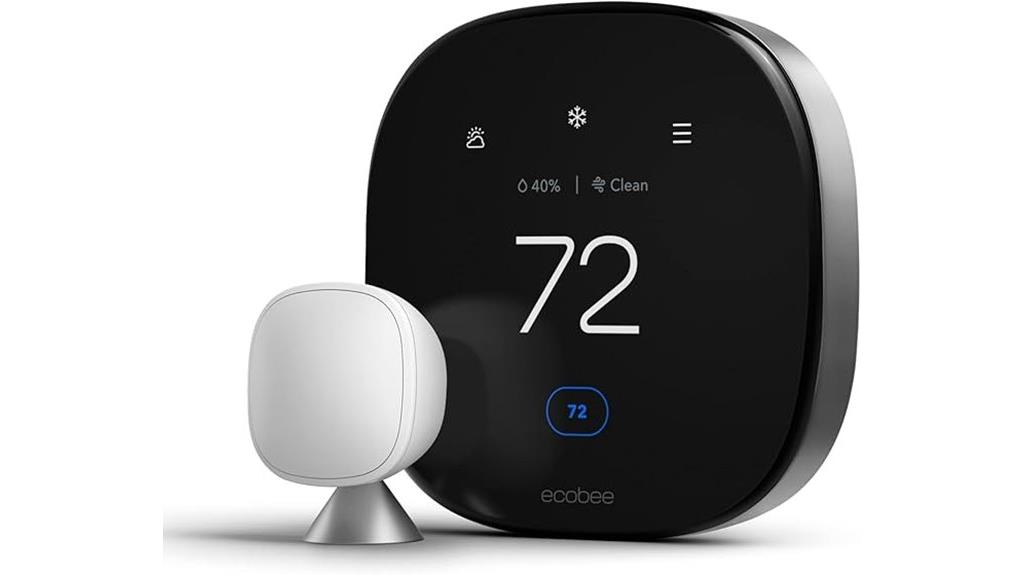
The ecobee Smart Thermostat Premium with Sensors and Air Quality Monitor stands out as an ideal choice for homeowners seeking extensive energy savings and enhanced indoor air quality. It can save up to 26% annually on heating and cooling costs and is ENERGY STAR certified. The included SmartSensors adjust temperature in key rooms, reducing hot and cold spots. Its built-in air quality monitor alerts you to poor air conditions and reminds you to change filters. Additionally, it detects temperature drops, preventing damage, and uses sensors to monitor door and window states for energy efficiency. With a sleek design, advanced display, voice control, and security features, it’s a all-encompassing smart solution.
Best For: homeowners seeking to maximize energy savings, improve indoor air quality, and enjoy advanced smart home features with seamless voice control and security integration.
Pros:
- Saves up to 26% annually on heating and cooling costs, promoting energy efficiency.
- Built-in air quality monitor and sensors help maintain healthy indoor environments and prevent damage.
- Stylish design with a large display, advanced interface, and compatibility with Siri and Alexa for convenient voice control.
Cons:
- Security features require an additional ecobee Smart Security plan.
- Apple Home Hub is necessary for Siri integration, which may add complexity for some users.
- Compatibility limited to most 24VAC HVAC systems; certain older or specialized systems might not be supported.
ecobee Smart Thermostat Enhanced, Programmable Wi-Fi Thermostat
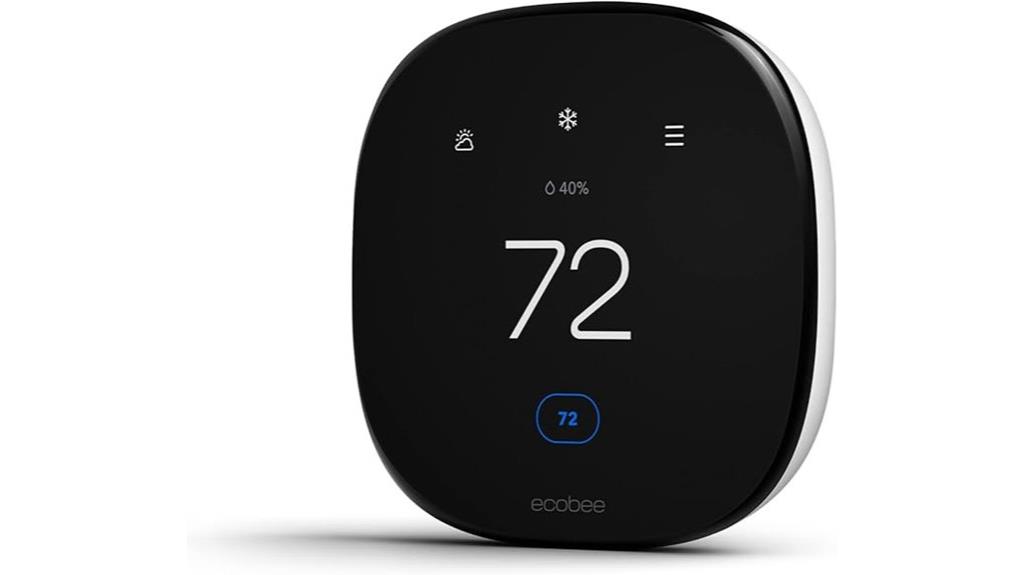
The ecobee Smart Thermostat Enhanced stands out for its advanced energy-saving features and seamless smart home integration, making it ideal for homeowners seeking both comfort and efficiency. It can save up to 26% annually on heating and cooling costs by automatically adjusting the temperature when you’re away. Preheating or precooling before arrival ensures immediate comfort, while humidity-based adjustments maintain consistent levels. With SmartSensor technology, it monitors room-specific temperatures, focusing on key areas. Compatibility with Siri, Alexa, Google Assistant, and remote control via the Ecobee app makes managing your home effortless. Easy to install and Energy Star certified, it’s a reliable choice for smart, energy-efficient living.
Best For: homeowners seeking an energy-efficient, smart thermostat that offers seamless integration with voice assistants and easy remote control.
Pros:
- Saves up to 26% annually on heating and cooling costs through intelligent adjustments.
- Compatible with major smart home platforms like Siri, Alexa, and Google Assistant for effortless control.
- Easy DIY installation, including support for homes without a C-Wire using the Power Extender Kit.
Cons:
- Requires Wi-Fi connection for optimal functionality, which may be a limitation in low-connectivity areas.
- Slightly higher upfront cost compared to basic thermostats.
- Advanced features and app controls may have a learning curve for some users.
Honeywell Home Smart Thermostat with WiFi Compatibility
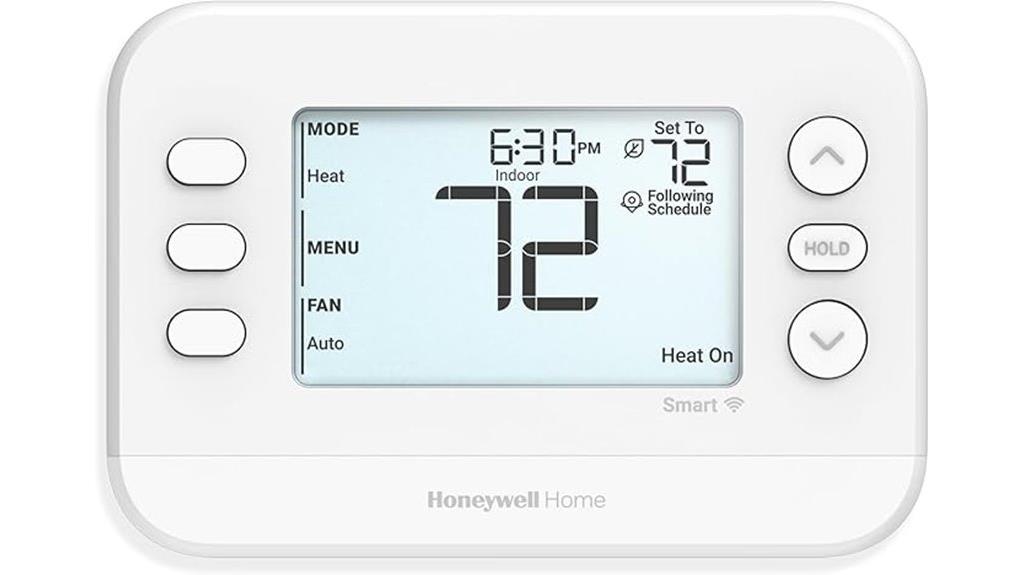
For homeowners seeking seamless integration with popular smart home platforms, the Honeywell Home X2S Smart Thermostat stands out thanks to its Matter certification. It supports conventional and heat pump systems, offering flexible scheduling and auto-away modes to optimize energy use. With WiFi connectivity and compatibility with Alexa, Google Assistant, and Apple HomeKit, setup is straightforward—especially if you have a C-wire. The device’s sleek design includes an LCD display and interchangeable accent panels. Users appreciate its reliable connection and easy control via app or voice commands, though some mention initial setup challenges and occasional WiFi issues. Overall, it’s a feature-rich thermostat for modern, connected homes.
Best For: homeowners seeking a sleek, reliable smart thermostat with seamless smart home platform integration and flexible scheduling capabilities.
Pros:
- Supports multiple smart home platforms including Alexa, Google Assistant, and Apple HomeKit, thanks to Matter certification.
- Easy setup and installation, especially with existing Honeywell systems and C-wire compatibility.
- Customizable features like scheduling, auto-away, humidity monitoring, and extended low-heat setpoints for personalized comfort and energy savings.
Cons:
- Occasional WiFi disconnections and initial setup challenges reported by some users.
- May require an adapter for non-Honeywell systems, adding complexity for certain installations.
- Customer support experiences vary, with some users citing difficulties in obtaining assistance.
ecobee Smart Thermostat Essential, Wi-Fi Programmable Thermostat
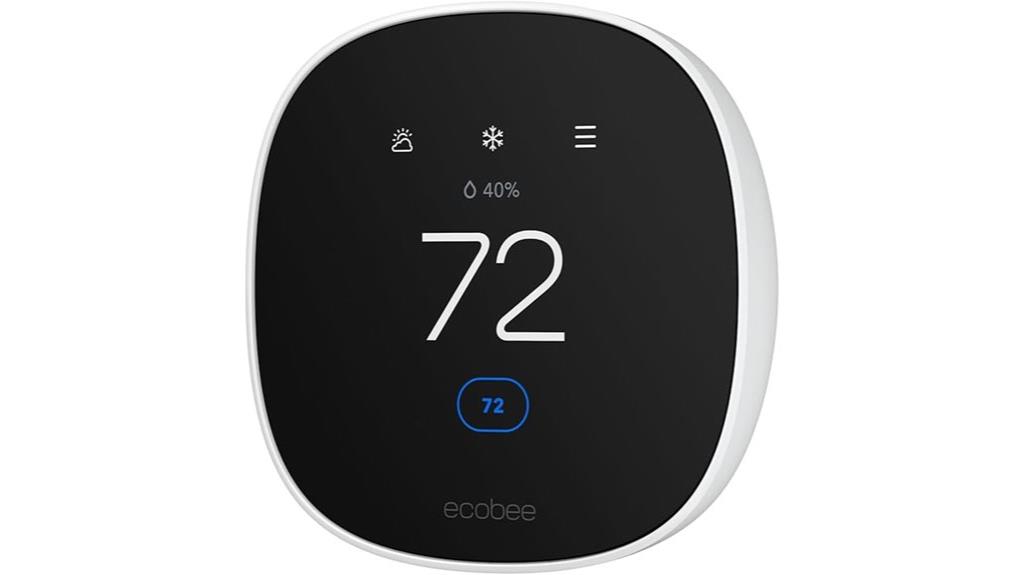
If you’re looking for an affordable yet feature-rich smart thermostat compatible with popular voice assistants and smart home systems, the ecobee Smart Thermostat Essential is an excellent choice. It’s Energy Star certified, Wi-Fi enabled, and works seamlessly with Siri, Alexa, Google Assistant, and Apple HomeKit. With an intuitive LCD display, touch controls, auto-scheduling, and auto-away mode, it helps optimize your HVAC system for efficiency. Designed for electric baseboard heaters, air conditioners, and furnaces, it can save up to 23% on energy bills. Installation is straightforward, and users report significant savings and easy app control, making it a cost-effective upgrade for modern homes.
Best For: homeowners seeking an affordable, easy-to-install smart thermostat compatible with multiple voice assistants and capable of reducing energy costs.
Pros:
- Energy Star certified with potential savings of up to 23% on utility bills
- Seamless integration with Siri, Alexa, Google Assistant, and Apple HomeKit
- Intuitive LCD display and simple app controls for easy scheduling and remote management
Cons:
- Limited scheduling flexibility with only one schedule per season
- Cannot set different schedules for different seasons without manual re-entry
- Basic features like fan control and temperature hold lack advanced customization options
Amazon Smart Thermostat
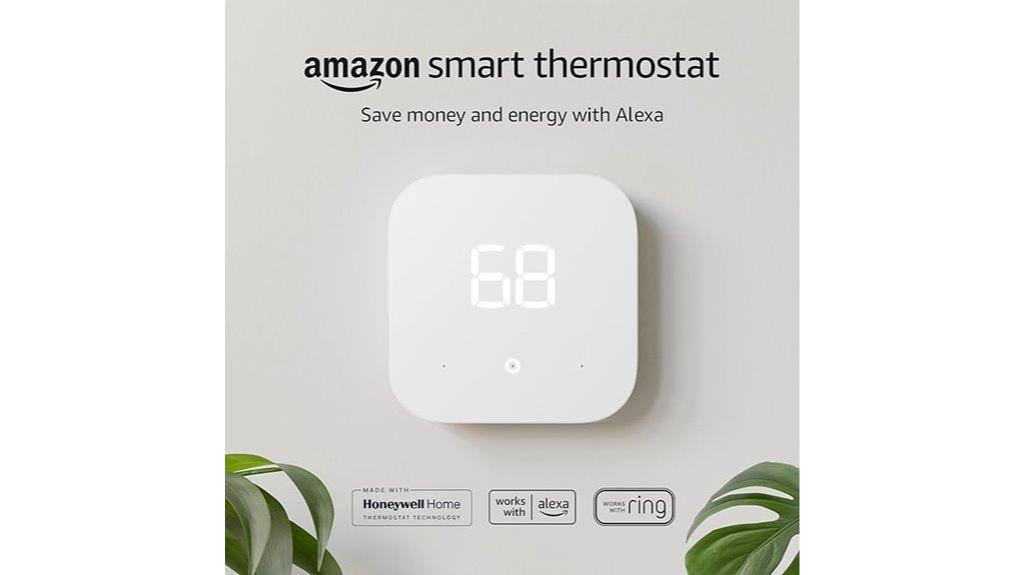
Looking to upgrade your home’s heating and cooling system with a smart thermostat that’s easy to install and integrates seamlessly with your existing devices? The Amazon Smart Thermostat is a great choice. It supports C-wire installation and works smoothly with Alexa and Ring devices, allowing voice control and smart home connectivity. You can control it remotely via the Alexa app, and it adjusts automatically based on your preferences. Built with Honeywell technology, it’s reliable and durable. Plus, it helps save energy and reduces costs—EPA estimates show about $50 saved annually. Amazon also offers guided setup and customer support, making installation straightforward and stress-free.
Best For: homeowners seeking an easy-to-install, reliable smart thermostat that seamlessly integrates with Alexa and Ring devices to optimize home comfort and energy savings.
Pros:
- Supports C-wire installation for versatile setup
- Integrates effortlessly with Alexa and Ring for voice control and automation
- Helps reduce energy bills, saving approximately $50 annually as per EPA estimates
Cons:
- May require professional installation if no C-wire is present
- Limited compatibility with some older HVAC systems
- Dependence on Wi-Fi connectivity for remote control and automation features
Honeywell WiFi Smart Thermostat (RTH8800WF2022)
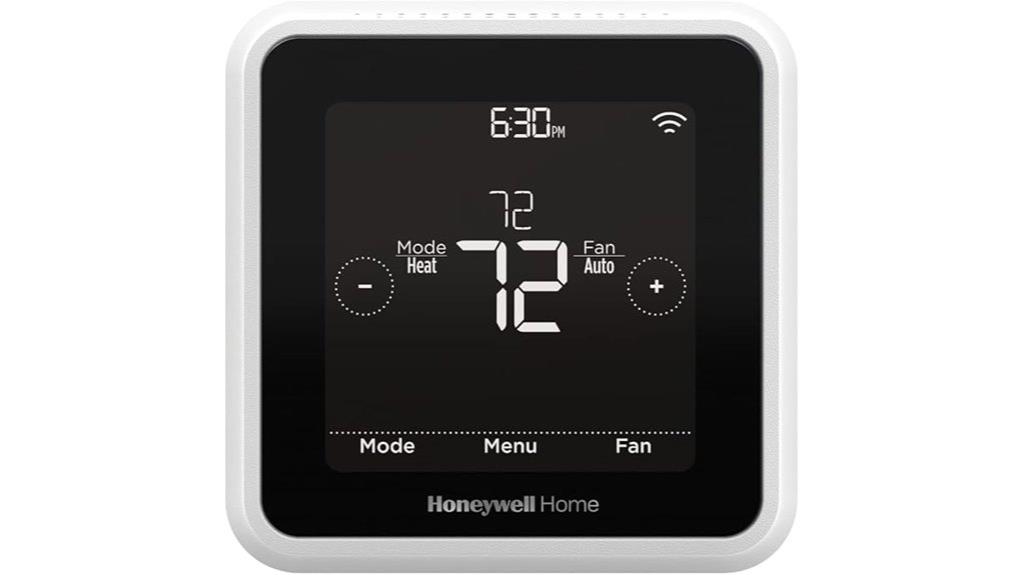
The Honeywell WiFi Smart Thermostat (RTH8800WF2022) stands out for its user-friendly touchscreen interface combined with robust scheduling options, making it an excellent choice for homeowners seeking precise control and energy savings. It supports most heat and cool systems, including oil furnaces, but requires a C-wire power adapter for installation. Its 7-day programming and geofencing technology help optimize comfort and reduce energy use, saving customers between 8-16% on bills. ENERGY STAR certified, it offers monthly energy reports and compatibility with Alexa for voice control. Overall, this thermostat combines ease of use with smart features that promote efficiency and convenience in home climate management.
Best For: homeowners seeking an easy-to-use, energy-efficient smart thermostat with customizable scheduling and voice control capabilities.
Pros:
- User-friendly touchscreen interface for simple programming and control
- Supports most heat/cool systems, including oil furnaces, with a C-wire adapter needed
- Offers 7-day scheduling, geofencing, and compatibility with Alexa for enhanced convenience
Cons:
- Not compatible with heating-only oil systems unless a C-wire is installed
- Requires a C-wire power adapter, which may necessitate additional setup or professional installation
- Savings vary depending on individual energy consumption and usage patterns
Google Nest Thermostat, Programmable Wi-Fi Smart Thermostat
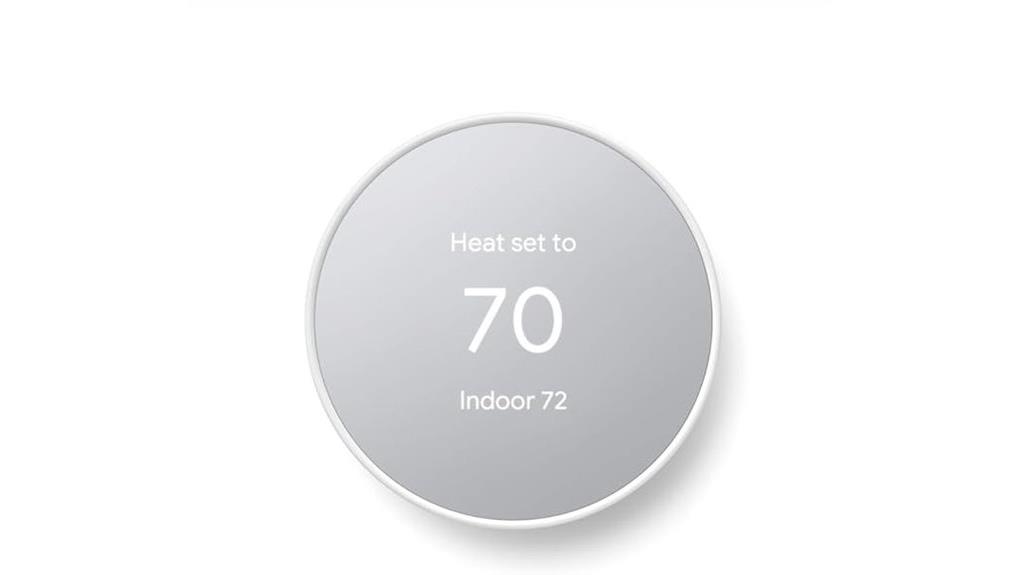
The Google Nest Thermostat is an excellent choice for homeowners seeking a sleek, energy-efficient smart thermostat that’s easy to install and control remotely. It’s ENERGY STAR certified, helping reduce energy use by automatically adjusting when you’re away. Supporting heating, cooling, and heat pump systems, it features a modern LCD display and simple button controls. Setup typically takes about 30 minutes, and you can manage it via the Google Home app or voice commands through Google Assistant, Alexa, or Matter-compatible devices. Its compatibility with various HVAC systems makes it a versatile, user-friendly option that integrates seamlessly into a connected home.
Best For: homeowners looking for an easy-to-install, energy-efficient smart thermostat with seamless remote control and compatibility with popular voice assistants.
Pros:
- ENERGY STAR certified, promoting energy savings and reducing utility bills
- Supports multiple HVAC systems including heating, cooling, and heat pumps
- Easy DIY installation typically completed within 30 minutes
Cons:
- Initial setup can be challenging due to wiring and system compatibility issues
- Limited offline functionality; dependent on internet connection for full features
- Some users report accuracy concerns with temperature and humidity readings
Sensi Smart Thermostat
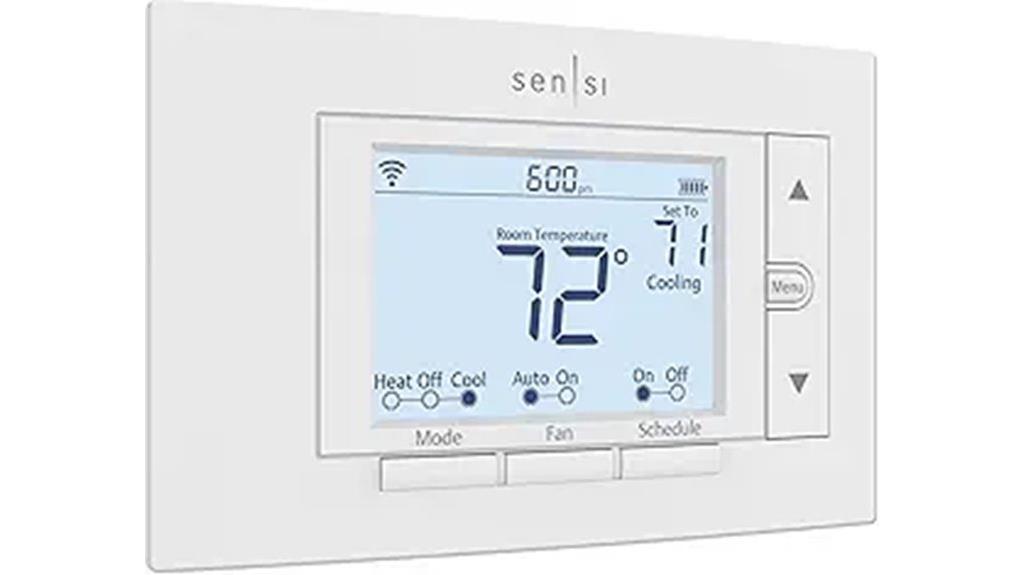
If you want a smart thermostat that’s easy to install and compatible with a wide range of HVAC systems, the Sensi Smart Thermostat is an excellent choice. It offers Wi-Fi connectivity, voice control with Alexa, Google Assistant, SmartThings, and Vera, plus a sleek LED display and simple button controls. Designed for DIY installation, it fits the same space as traditional thermostats and often doesn’t require a c-wire. It features scheduling, remote access, filter alerts, humidity management, and Energy Star certification, helping you save around 23% on energy bills. Users praise its reliability, ease of use, and compatibility, making it a solid addition to any smart home.
Best For: homeowners seeking an easy-to-install, compatible, and energy-efficient smart thermostat with reliable performance.
Pros:
- User-friendly DIY installation with clear app instructions and physical controls
- Compatible with a wide range of HVAC systems, often without needing a c-wire
- Energy Star certified, helping users save approximately 23% on energy bills
Cons:
- Limited detailed usage data and analytics in the app
- No support for Bixby voice control
- Occasional connectivity or setting adjustment issues reported by some users
Honeywell Smart Wi-Fi Touch Screen Thermostat
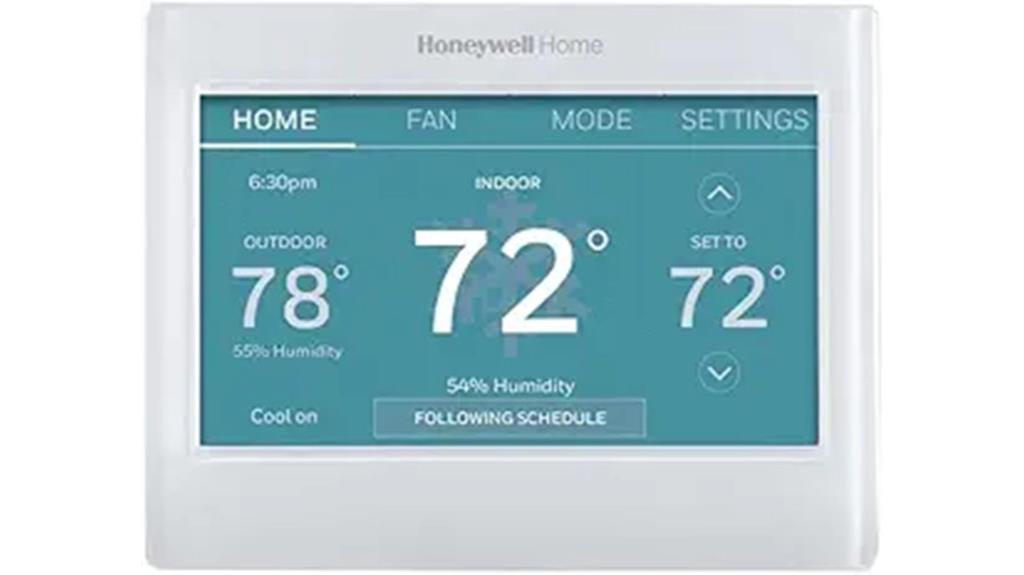
Looking for a smart thermostat that combines energy efficiency with customizable control? The Honeywell Smart Wi-Fi Touch Screen Thermostat is a great choice. It’s ENERGY STAR certified, helping you save on energy bills while offering personalized tips to reduce consumption. You can control it remotely via the app or integrate it with Amazon Alexa, Google Assistant, and other platforms. Its high-definition color display is customizable and shows indoor/outdoor temps, humidity, and weather forecasts. Suitable for various forced air systems, it requires a C-wire for installation. This thermostat enhances comfort, saves energy, and fits seamlessly into a smart home setup.
Best For: homeowners seeking an ENERGY STAR certified, customizable, and remotely controllable smart thermostat compatible with various forced air heating systems.
Pros:
- ENERGY STAR certification helps reduce energy bills through efficient operation and personalized energy-saving tips.
- Compatible with Amazon Alexa, Google Assistant, and other smart home platforms for seamless voice control and automation.
- High-definition color display is customizable and provides detailed on-screen info like indoor/outdoor temperature, humidity, and weather forecasts.
Cons:
- Requires a C-wire for installation, which may necessitate additional wiring or adapters in some homes.
- Not compatible with electric baseboard heating systems (120-240V), limiting its use in certain setups.
- Not suitable for line voltage heating systems, so compatibility should be verified before purchase.
Sensi Touch 2 Smart Thermostat with Touchscreen Display
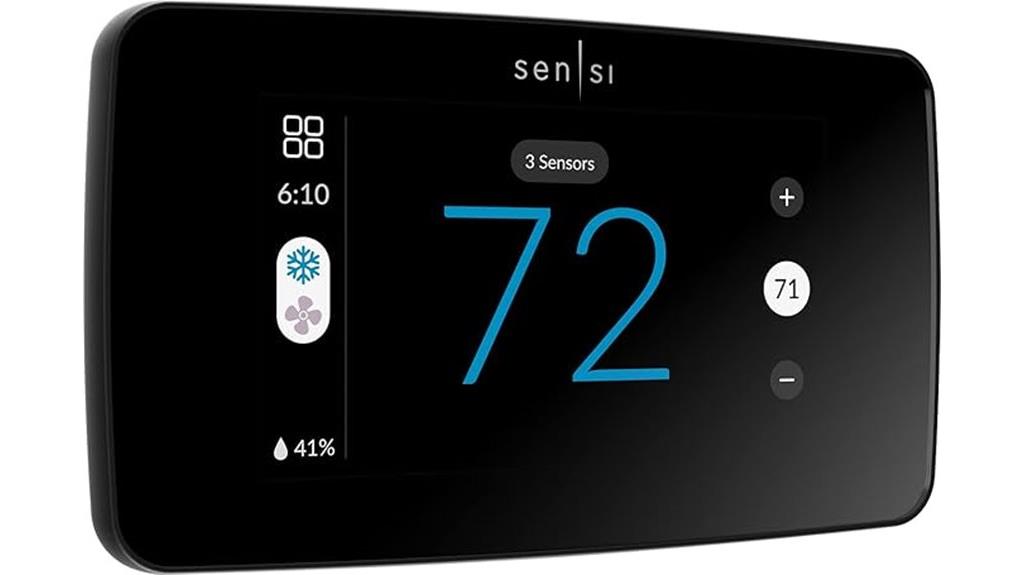
For homeowners seeking a sleek, user-friendly thermostat with all-encompassing control options, the Sensi Touch 2 Smart Thermostat with Touchscreen Display stands out. It features a modern LCD touchscreen, Wi-Fi connectivity, and compatibility with voice assistants like Alexa, Google Assistant, and Samsung SmartThings. Designed for easy DIY installation, it supports room sensors to balance temperatures and boost efficiency. It can save around 23% on energy costs through scheduling and remote access, while also providing maintenance alerts. With a simple app interface, privacy focus, and reliable performance, it’s a solid choice for those wanting smart, customizable home climate control.
Best For: homeowners seeking an easy-to-use, customizable, and energy-efficient smart thermostat with modern design and compatible voice control options.
Pros:
- Sleek LCD touchscreen display with intuitive app interface for easy control.
- Compatible with popular voice assistants like Alexa, Google Assistant, and Samsung SmartThings.
- Supports room sensors to improve comfort and optimize energy savings across different areas.
Cons:
- Limited temperature adjustment ranges for auxiliary heat or very low temperatures.
- Difficulty in accessing outside temperature data directly on the thermostat.
- Some users report challenges reaching technical support and concerns with hardware reliability.
Sensi Lite Smart Thermostat
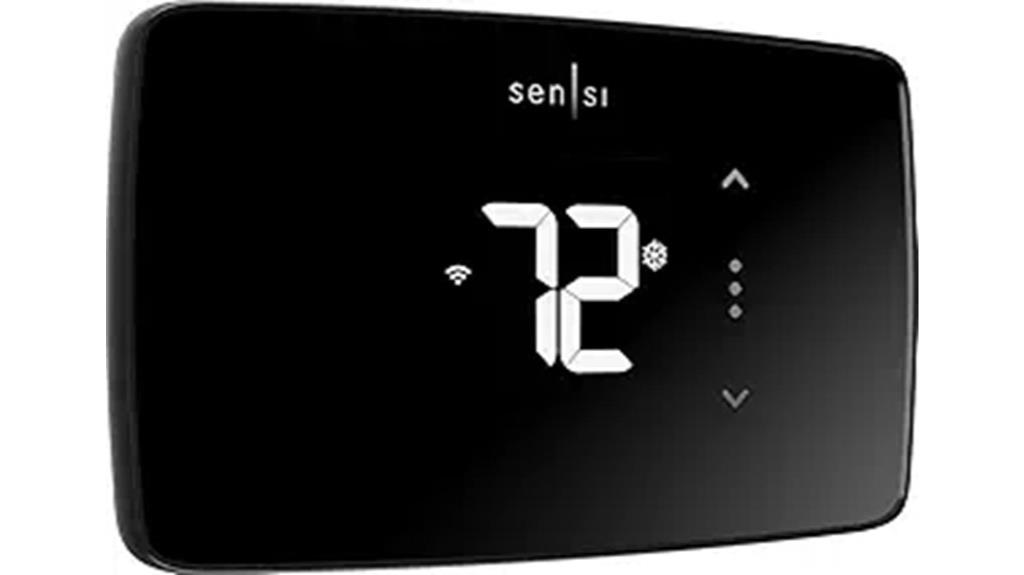
The Sensi Lite Smart Thermostat by Emerson stands out for homeowners seeking an easy-to-install, energy-efficient device compatible with a wide range of HVAC systems. This Energy Star-certified model offers a sleek design with an LCD display, backlight, and simple controls. It supports Wi-Fi app control and works seamlessly with Alexa, Google Assistant, and SmartThings. Installation is straightforward, often requiring minimal wiring and no C-wire, except for heat pump or heat/cool systems. Features like programmable schedules, filter indicators, and auto changeover help save energy and boost comfort. Despite some connectivity challenges, users appreciate its affordability, ease of use, and compatibility with most 24V HVAC setups.
Best For: homeowners seeking an easy-to-install, energy-efficient smart thermostat compatible with a variety of HVAC systems without the need for extensive wiring.
Pros:
- Simple DIY installation with minimal wiring required, suitable for most 24V systems
- Supports remote control via app and integrates with Alexa, Google Assistant, and SmartThings
- Energy Star certified, helping to save approximately 23% on HVAC energy use
Cons:
- Connectivity issues can occur, especially after power outages or battery changes, requiring troubleshooting
- Limited app statistics and scheduling flexibility compared to higher-end models
- Not recommended for use outside US/Canada and may face setup challenges with non-standard wiring
Honeywell Home Wi-Fi 7-Day Programmable Thermostat, RTH6580WF
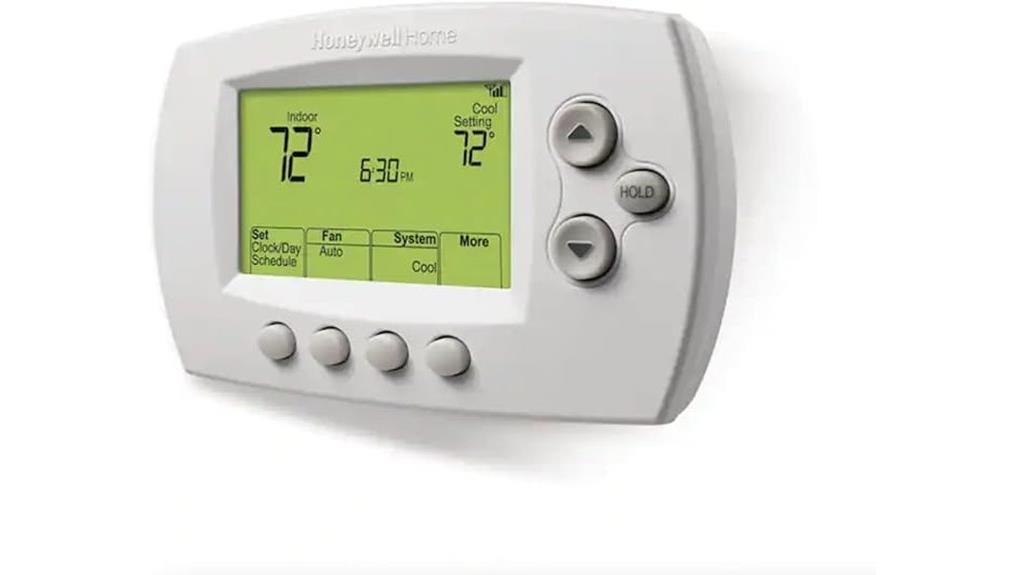
The Honeywell Home Wi-Fi 7-Day Programmable Thermostat (RTH6580WF) stands out as an excellent choice for budget-conscious homeowners who want reliable, remote control over their heating and cooling systems. It’s ENERGY STAR certified, helping you conserve energy with monthly reports and personalized tips. Compatible with Alexa, Google Assistant, and Cortana, it offers flexible 7-day, 4-period programming. The large, backlit display and intuitive controls make setup easy, and app management via Total Connect Comfort or Resideo ensures remote access. Just make certain your HVAC has a C-wire or use the included adapter. Overall, it’s a user-friendly, affordable option for smart home climate control.
Best For: budget-conscious homeowners seeking reliable, remote-controlled smart thermostat options compatible with popular voice assistants.
Pros:
- Easy to install and set up, with user-friendly controls and clear instructions
- ENERGY STAR certified, promoting energy savings through reports and tips
- Compatible with Alexa, Google Assistant, and Cortana for voice control
Cons:
- Requires a C-wire or the use of an included adapter for power
- Limited detailed energy usage data and lockout features
- Dependence on cloud servers means control may be disrupted during outages
Vine Thermostat with Touchscreen and WiFi
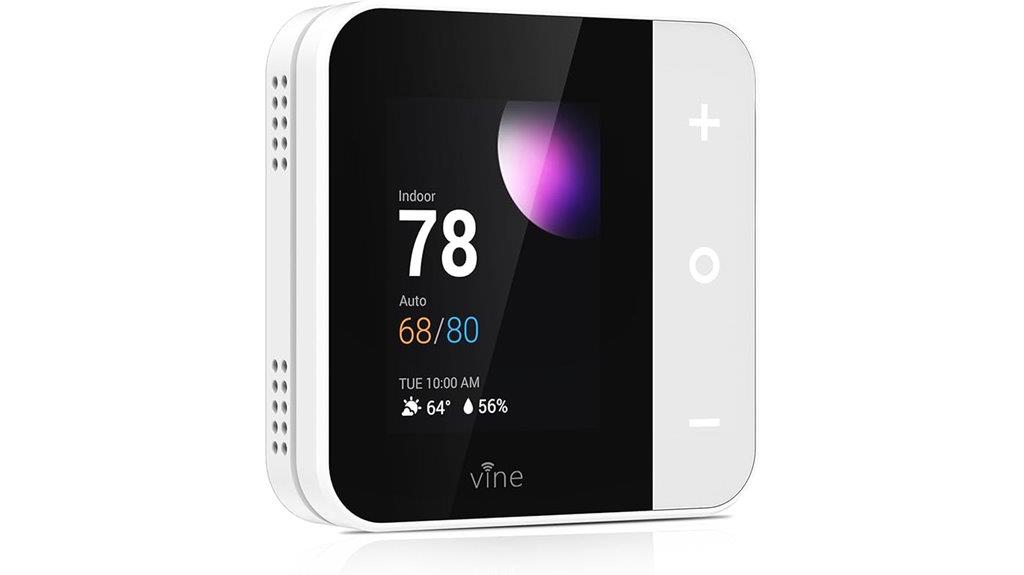
With support for 90% of system types and quick installation, the Vine Thermostat with Touchscreen and WiFi stands out as an excellent choice for homeowners seeking a versatile and user-friendly smart thermostat. It works with conventional, heat pump, gas, electric, oil, and dual-fuel systems, all requiring a C-wire. Setup is simple and quick, often completed in around 20 minutes using online guides and videos. You can control it remotely via the Vine or Smart Life app, and it’s compatible with Alexa and Google Assistant for voice commands. The sleek 2.8-inch touchscreen display makes programming and adjustments intuitive, blending modern aesthetics with practical functionality.
Best For: homeowners seeking a versatile, easy-to-install smart thermostat compatible with a wide range of HVAC systems and looking for remote control and voice assistant integration.
Pros:
- Supports 90% of system types, including conventional, heat pump, gas, electric, oil, and dual-fuel systems
- Quick installation process, typically completed within 20 minutes with online guides and videos
- Compatible with smartphone apps, Alexa, and Google Assistant for convenient remote control and voice commands
Cons:
- Requires a C-wire for installation, which may not be present in all setups
- Limited to a 2.8-inch touchscreen display, which might feel small to some users
- May require internet connectivity for remote features and app control, limiting functionality during outages
Google Nest Learning Thermostat (3rd Gen, 2015) – Programmable Smart Thermostat
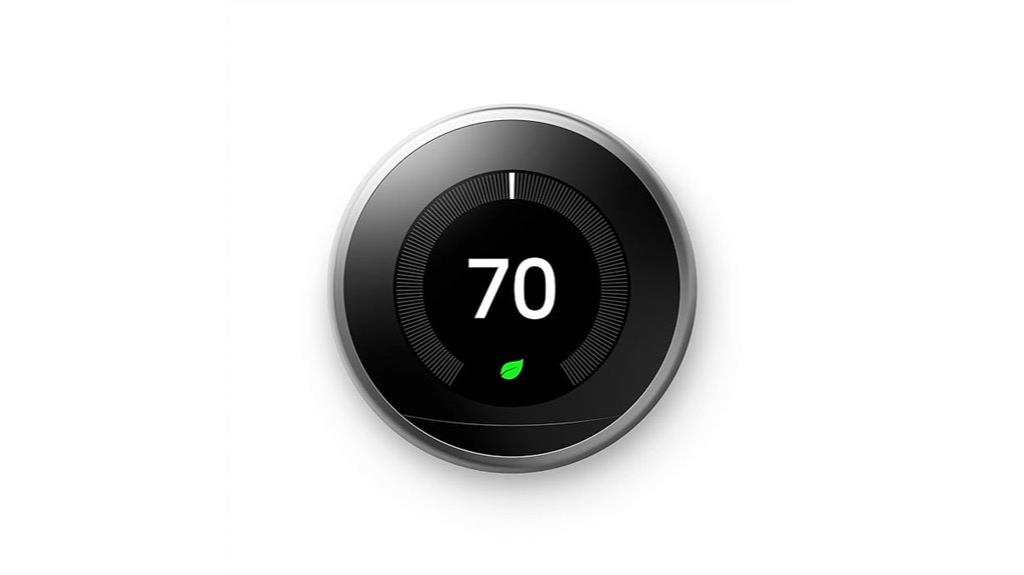
If you’re looking for a smart thermostat that automatically adapts to your routines and helps cut energy costs, the Google Nest Learning Thermostat (3rd Gen, 2015) is an excellent choice. It learns your preferences and creates a personalized schedule, eliminating manual programming. The thermostat displays your energy history and shows the Nest Leaf when you choose energy-saving temperatures, encouraging efficiency. With Home/Away Assist, it adjusts temperatures when you’re gone, reducing waste. You can control it remotely via the Nest app from anywhere. Compatibility checks are recommended before purchasing to ensure it works with your system, making it a smart, energy-conscious upgrade.
Best For: homeowners seeking an energy-efficient, self-learning thermostat that can be controlled remotely and seamlessly integrates with smart home systems.
Pros:
- Learns user preferences to create personalized schedules automatically
- Helps reduce energy consumption and lower utility bills with features like Home/Away Assist and Energy History
- Compatible with voice assistants like Alexa and controllable via the Nest app remotely
Cons:
- Requires a compatibility check before purchase to ensure proper system integration
- May have a learning curve for users unfamiliar with smart thermostats
- Limited to the 3rd generation features, with newer models offering additional functionalities
Factors to Consider When Choosing a Smart Thermostat Compatible With Matter
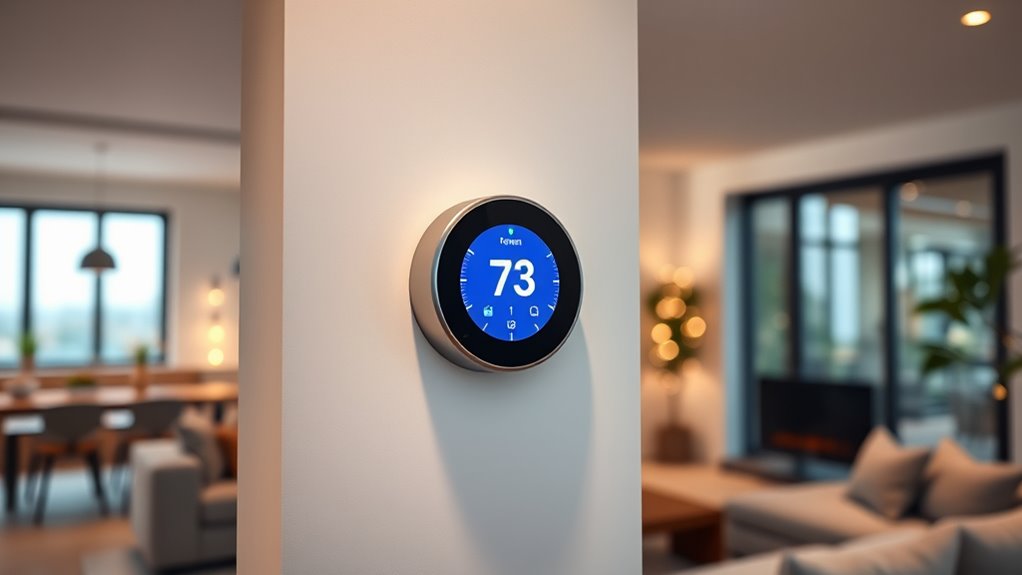
When choosing a smart thermostat that works with Matter, I consider key factors like compatibility with my HVAC system, voice assistant support, and wireless connectivity options. I also think about energy-saving features and how easy it is to install. These points help guarantee I pick a device that fits my needs and setup perfectly.
Compatibility With HVAC Types
Choosing a smart thermostat that’s compatible with your HVAC system requires careful consideration of the specific equipment you have. Not all thermostats work with every system, so I recommend checking if the device supports your HVAC setup, whether it’s a furnace, air conditioner, heat pump, boiler, or dual fuel system. Verify that it matches your system’s voltage, like 24V AC, and see if a C-wire or power extender is needed for continuous operation. If you have specialized systems, such as zone controls, multi-stage heating or cooling, or electric baseboard heaters, ensure the thermostat explicitly supports those configurations. Compatibility with your system’s control protocols is essential for seamless operation, so always confirm the thermostat can handle your HVAC’s unique wiring and complexity.
Voice Assistant Support
Supporting popular voice assistants like Amazon Alexa, Google Assistant, Apple Siri, or Samsung Bixby is essential for a smart thermostat, especially when aiming for seamless hands-free control. I look for devices that support these platforms to guarantee I can adjust settings effortlessly with just my voice. It’s important that the thermostat is Matter-certified, guaranteeing compatibility across multiple voice platforms and smart home ecosystems. I also verify that the voice integration offers hands-free operation, allowing me to change the temperature, switch modes, or set schedules without lifting a finger. Natural language processing is a bonus, making commands more intuitive and responsive. Ultimately, I check whether the voice platform is compatible with my existing smart home setup to avoid any integration issues and ensure smooth operation.
Wireless Connectivity Options
Wireless connectivity options play a pivotal role in how effectively a smart thermostat integrates with my smart home system. Most modern models support Wi-Fi, usually on 2.4GHz or 5GHz bands, which is essential for remote control and compatibility with smart platforms. Some thermostats also use Bluetooth Low Energy (BLE), providing short-range pairing and added control options. For enhanced reliability and automation, many include Zigbee or Z-Wave protocols, allowing local mesh networks with compatible hubs. Matter certification is a significant advantage, ensuring seamless communication across various ecosystems via IP-based protocols, often through Wi-Fi or Ethernet. Reliable connectivity depends on a stable internet connection, proper network setup, and sometimes range extenders or mesh networks to keep your thermostat responsive and connected.
Energy Saving Features
Energy-saving features are essential when selecting a smart thermostat, especially one compatible with Matter, because they directly impact your utility bills and environmental footprint. I look for models with advanced scheduling and occupancy sensing, which can cut energy use by up to 26%. Real-time energy tracking and detailed reports help me identify habits to improve efficiency. Geofencing is another useful feature; it adjusts the temperature based on my proximity, preventing unnecessary HVAC operation. I also prefer thermostats with energy-saving modes like auto-away or adaptive learning, which automatically fine-tune settings based on my routines. Ultimately, checking if the device supports energy rebate programs and demand response services ensures I maximize savings while supporting grid efficiency. These features help me maintain comfort while reducing costs and environmental impact.
Installation Requirements
When choosing a smart thermostat that works with Matter, understanding installation requirements helps guarantee a smooth setup. First, check if your system has a C-wire or if the thermostat offers a compatible power extender kit, especially if your system lacks a common wire. Confirm the installation process is straightforward and compatible with your existing HVAC wiring. It’s also important to verify the mounting options—whether wall-mounted or adhesive-backed—to fit your space. Additionally, look for thermostats that provide clear, detailed installation instructions and support DIY setup or professional installation. Finally, verify that the device’s hardware and firmware support the Matter protocol, ensuring seamless integration with your smart home ecosystem without compatibility issues.
Integration Ecosystem
Choosing a smart thermostat that supports the Matter protocol guarantees it can easily connect and work seamlessly within your existing smart home ecosystem. With Matter compatibility, your thermostat can integrate smoothly with platforms like Apple Home, Google Home, Amazon Alexa, and Samsung SmartThings, eliminating the need for multiple apps or bridges. This unified control simplifies managing your devices and enhances user experience. Additionally, Matter-enabled devices support local control and automation, reducing dependence on cloud services and improving reliability during internet outages. Future-proofing is another key benefit, as more smart home devices adopt the Matter standard for better interoperability. Plus, the protocol’s emphasis on secure, standardized communication helps protect your data and ensures your smart home setup remains safe and reliable.
Frequently Asked Questions
How Does Matter Compatibility Improve Smart Thermostat Integration?
When I think about how Matter compatibility improves smart thermostat integration, I realize it makes everything much simpler. It allows my thermostat to seamlessly communicate with other smart devices, regardless of brand. This means I can control my thermostat through one app or voice command, without worrying about compatibility issues. Overall, Matter creates a more unified and user-friendly smart home experience, making it easier to manage everything effortlessly.
Are All Smart Thermostats Compatible With Voice Assistants via Matter?
Not all smart thermostats are compatible with voice assistants through Matter. While Matter aims to unify smart home devices, some thermostats may still rely on their native ecosystems or specific voice platforms. I recommend checking each thermostat’s specifications to see if it supports your preferred voice assistant via Matter. This way, you can enjoy seamless control without compatibility issues.
What Security Features Are Standard in Matter-Compatible Thermostats?
Imagine locking your home’s secrets with a digital key—security is essential. Matter-compatible thermostats typically include robust features like end-to-end encryption, secure device onboarding, and regular firmware updates to patch vulnerabilities. Many also support multi-factor authentication and device isolation, ensuring your data stays private. I feel confident knowing these standards are in place, because they protect my home network from potential threats while giving me seamless control over my environment.
Can Matter-Enabled Thermostats Be Controlled Remotely Without Internet?
Matter-enabled thermostats typically require an internet connection for remote control, as they rely on cloud services to sync and manage settings. However, some models offer local control via a hub or direct connection, allowing you to adjust your thermostat without internet. Still, for most seamless remote access, an internet connection is vital. I recommend checking specific device features to ensure they meet your remote control needs.
Do Matter-Compatible Thermostats Support Energy-Saving Automation?
When I think about energy-saving automation, I see it as a smart way to reduce costs and environmental impact. Matter-compatible thermostats support this by allowing me to set schedules, adjust temperatures remotely, and optimize heating or cooling based on my routines. This seamless integration makes it easy to save energy without sacrificing comfort, giving me peace of mind knowing my home is efficient while I focus on what matters most.
Conclusion
Choosing a smart thermostat compatible with Matter makes home control effortless, like having a genie in a bottle—minus the magic lamp. With options ranging from the sleek Vine to the advanced ecobee models, you’re set for seamless integration. Just remember, in this fast-paced world, embracing smart tech is like sailing a ship through modern waters—staying ahead means adapting quickly. So, pick one that fits your needs and enjoy a smarter, more comfortable home.


